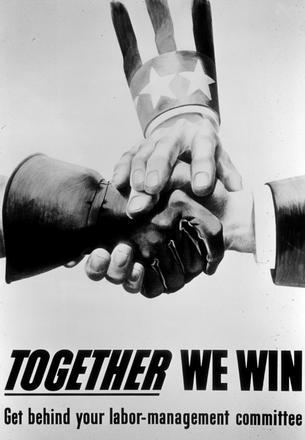
On this day in labor history, the year was 1942.
That was the day President Franklin Roosevelt established the National War Labor Board under Executive Order 9017.
The Board was designed to mediate and settle disputes in the various defense industries.
Its purpose was to prevent any strikes or lockouts that would interfere with war production.
The War Labor Board consisted of twelve representatives: four each from industry, labor and the public.
It established procedures for dispute resolution and detailed the scope of grievances, arbitrations and award enforcement.
The Board had the authority to issue binding agreements and to recommend government seizure of plants involved in work stoppages.
It instituted the “Little Steel” Formula to allow for cost of living wage increases, in an effort to stem inflation.
In exchange for the no-strike pledge, it instituted “maintenance of membership” in unionized workplaces, which made union membership automatic for new hires and mandated employer collection of union dues.
During the war, it imposed tens of thousands of wage-dispute settlements and wage agreements.
In a 1942 case against General Motors, the Board mandated equal pay for equal work for women and minorities. ]
Those critical of the Board opposed the no-strike pledge and compulsory arbitration as clampdowns on Labor’s power and independence.
They argued it was stacked with open-shop advocates, enforced wage controls and freezes, and encumbered workers with endless red tape, run-arounds and delays in resolutions.
Labor historian Steve Fraser notes that after the 1942 elections, pro-business appointees made union organizing efforts throughout the South and in the retail and service sectors difficult.
It ceased to function at the end of 1935, though it set precedents for arbitration that are still in use today.
More Episodes
 2024-02-07
2024-02-07
 2024-02-07
2024-02-07
 2024-01-30
2024-01-30
 2024-01-28
2024-01-28
 2024-01-27
2024-01-27
 2024-01-27
2024-01-27
 2024-01-21
2024-01-21
 2024-01-20
2024-01-20
 2024-01-20
2024-01-20
 2024-01-20
2024-01-20
 2024-01-16
2024-01-16
Create your
podcast in
minutes
- Full-featured podcast site
- Unlimited storage and bandwidth
- Comprehensive podcast stats
- Distribute to Apple Podcasts, Spotify, and more
- Make money with your podcast
It is Free
- Privacy Policy
- Cookie Policy
- Terms of Use
- Consent Preferences
- Copyright © 2015-2024 Podbean.com




